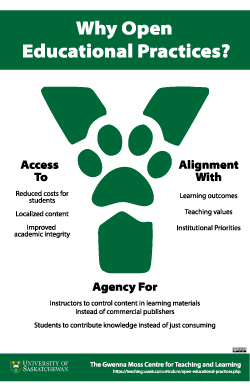What's Open?
- Materials are accessible so everyone can use them: it is free, works well with screen readers, no password required, etc.
- Anyone can create, collaborate on, and share the materials.
- There are choices for the creator of the materials as to what they will create and how they will share it.
- Research data and publications available for everyone to access and use.
- Reflections on teaching and learning so others may learn from our experiences.
Why choose Open?

Why use Open Educational Practices (OEP)?
Access to:
- Reduced costs for students
- Localized content
- Improved academic integrity
- Learning outcomes
- Teaching values
- Institutional Priorities
- Instructors to control content in learning materials instead of commercial publishers.
- Students to contribute knowledge instead of just consuming.
Finding Open Textbooks
There are a growing number of open textbooks available across most disciplines. You can search for books on the following websites or browse by discipline areas.
If you are looking for Open Resources to use in your course, you can connect with the University Library, and seek out a Library Liaison in your discipline to help.
| Site Name | Link |
|---|---|
| SaskOER Network (NEW!) -- formerly called USask Open Textbook Catalogue Continue to use the same username and password you have used for OpenPress. |
https://www.saskoer.ca/ |
| B.C. Open Collection by BCcampus | https://collection.bccampus.ca/ |
| LibreText | https://libretexts.org/ |
| OpenStax (Rice Univeristy) | https://openstax.org/ |
| Open Textbook Library (University of Minnesota) | https://open.umn.edu/opentextbooks |
| Pressbooks Directory | https://pressbooks.directory/ |
Browse by Discipline Area:
Open Pedagogy
Taking an open pedagogy approach to assessment allows students to contribute to creating knowledge and resources that demonstrate their learning and provide opportunities to show how their learning and the discipline can contribute to helping local communities and the world address the challenges we face today. This approach increases engagement and may help address instructor concerns related to academic integrity.
Several open pedagogy projects have been integrated into courses at USask. Read about some of them and see additional examples on the Open Pedagogy page.
Funding
Funding is available to support creation of Open Educational Resource (OER) projects and Open Pedagogy (OP) projects. The amount of funding you can receive will depend on the type of project and the number of students who will directly benefit from the project each year at USask.
Support & Technologies
Whether or not you receive funding for an open project, there are supports and tools available for use with your project, including:
- assistance finding existing OER,
- help understanding and navigating copyright and open licensing,
- consultation on the instructional design aspects of an open resource,
- consultation with developing an open pedagogy project, and
- assistance with using Pressbooks, Wordpress, or the Harvest Open Educational Resource Collection.
Tools
Homework Systems
Homework systems are online tools that can grade questions asked to students as homework, track formative practice, or assess examinations. They are most useful in classes where students are problem solving, for example math or chemistry, and need immediate feedback about if they have done the process correctly. Homework systems are also commonly used to test recall.
Homework systems can be commercial, student-pay systems or non-commercial (free) systems. For a comparison of the pros and cons of commercial systems, as well as a list of alternatives, please follow the link below.
Open Courses
USask has offered at least five open courses since 2014. The most recent courses include:
Get support
For support or a consultation on this topic, reach out to the team at the Gwenna Moss Centre for Teaching and Learning.

